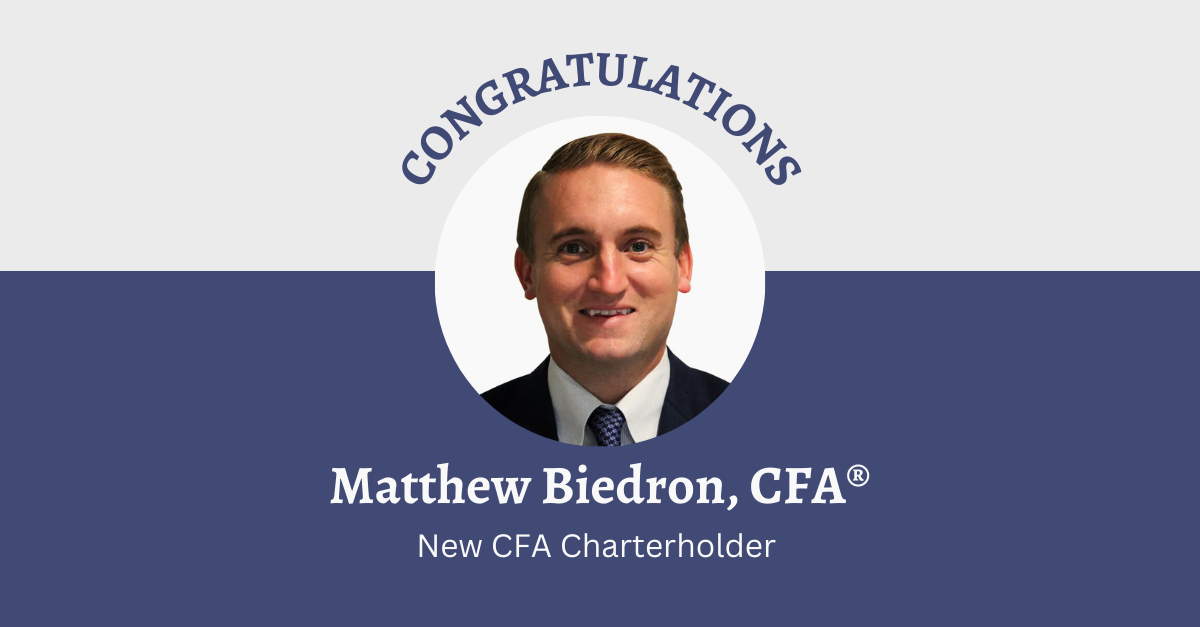High-Net-Worth Tax Planning Tips
November 15, 2021
If you have above $5 million in liquid assets, keep reading.
Here are some methods to potentially save on taxes. But some of them are time-limited (unless the government extends them), so determine which alternatives make sense for you.
1. Municipal Bonds
Assume you earn 3% from municipal bonds and 6% from equities mutual funds. Municipal bonds will likely have a long-term growth rate less than equities in general, but the interest is tax-free. After taxes, the municipal bonds aren't far behind.
According to OLA Senior Portfolio Manager James Lynch, bonds can help stabilize your portfolio in a down market. "I recommend bonds be part of any sound asset allocation,"
stated Lynch. "If you are going to invest in bonds, consider adding municipal bonds. Some states also exclude interest on municipal bonds, so living in one of those states saves double."
2. Convert Your IRA or 401k to a Roth
Roths have contribution limits, and high-net-worth individuals are usually excluded. An alternative to consider may be to convert your conventional IRA and 401k to a Roth.
Some individuals prefer to roll over a part of their assets into a Roth each year to keep taxes low. Because you pay taxes on the money you roll into your Roth in the year you do it, the sooner you invest, it may grow tax-free. But you can become more innovative by combining Roth conversions with other tax-saving techniques on our list.
3. Take Advantage of the 529 Plan Contribution
Savers can invest in a 529 plan, and the gains from the investments are free of capital gains, so long as the funds are used to pay for qualified expenses. Since 2017, parents can now withdraw up to $10,000 per year from a 529 plan to pay for private primary and secondary education tuition (if your state allows it) as well as colleges. However, it only allows for up to $10k per year, and it only covers tuition.
Many states offer tax deductions or credits when parents or grandparents fund 529 accounts. See a full list of the 529 plan deductions by state here.
4. Maximize Your Health Savings Account
Your HSA allows you to contribute $3,450 per person or $6,900 per pair. If you are 55 or older, you may add an additional $1,000.
HSAs grow tax-free and may be utilized for medical expenditures at any time. The money doesn't have to be spent or lost every year like a flexible spending account (FSA).
5. Update Your Real Estate Plan
The days of significant real estate tax write-offs are now gone. The new tax legislation lowered the maximum mortgage value to $750,000. And other mortgage interest is no longer deductible. Consider adjusting your real estate strategy to concentrate more on profitability and income rather than tax reduction.
6. Give More
The new tax legislation increased the standard deduction for couples to $24,000. You may also deduct up to 60% of your adjusted gross income (and 30% of appreciated assets) as a charitable contribution.
Making charitable donations reduces the amount of money that the government may utilize for its own purposes. You'll also save money on taxes.
7. Utilize a Donor Advised Fund (DAF)
You may remember our March 2021
article about the importance of DAFs and their increased growth over the past decade, with almost 13% of individual giving going into these funds.
When you contribute cash, securities or other assets to a donor-advised fund at a public charity, you are generally eligible to take an immediate tax deduction. Then those funds can be invested for tax-free growth, and you can recommend grants to virtually any IRS-qualified public charity.
The excellent news is that you may deduct your DAF contributions the year you make them, not when you donate the funds. If you want to leave this money to your heirs to donate, you may do so.

Looking for Mispriced Opportunities in a Chaotic Market The global equity markets have recently experienced a significant period of volatility, shaped by a mix of macroeconomic developments and policy shifts. The sell-off in the S&P 500 was driven mostly by tariff-related concerns, though it managed a partial recovery toward the end of the quarter. Concerns around economic growth intensified, fueled by softer economic data and uncertainty surrounding the broader “Trump 2.0” policy framework. Survey data reflected this caution, as the March Michigan Consumer Sentiment Index fell to its lowest since November 2022, with one-year inflation expectations rising to 5% and five-year expectations hitting a 32-year high of 4.1%. The March Consumer Confidence Index also dropped to its lowest since January 2021, with the expectation component reaching a 12-year low. Manufacturing PMI swung back into contraction, with cost pressure rising at the sharpest pace in 23 months. All in, the S&P 500 declined -4.59% in 1Q25, which marked its weakest performance since 3Q22. The best-performing sectors were Energy (+9.30%), Healthcare (+6.08%) and Consumer Staples. Conversely, sectors that underperformed were Industrials (0.53%), Communication Services (-6.41%), and Technology (-12.79%). High single-stock concentration levels in the S&P 500 Index, Deep Seek Artificial Intelligence developments, and elevated valuation multiples resulted in the Magnificent Seven stocks underperforming the broader market. In fact, the Magnificent Seven collectively fell into bear market territory, as the group declined -15% during 1Q25 and is now down -20% since the peak in December 2024.

White Paper: The Importance of Reinvestment Opportunities in Driving Intrinsic Value Executive Summary At Oliver Luxxe, we believe that the intrinsic value of an asset stems from its ability to generate sustainable cash flows over time, discounted at an appropriate required rate of return. Central to this valuation framework are three key drivers: return on invested capital (ROIC) , reinvestment opportunities , and the quality and sustainability of earnings . Through our proprietary quantitative screening process and rigorous fundamental analysis, we seek to identify companies with these characteristics. Our "Private Equity in the Public Marketplace" approach integrates detailed financial modeling and competitive positioning analysis to uncover businesses with compelling reinvestment opportunities. This white paper explores the critical role of reinvestment opportunities in value creation, the metrics that illuminate a firm’s capacity to reinvest effectively, and how sustainable free cash flow acts as a catalyst for long-term growth. The Foundations of Intrinsic Value We believe the value of any asset is fundamentally tied to the present value of its future cash flow, discounted by a rate that reflects the risk and opportunity cost of capital. For equity investors, this translates into a focus on three interconnected pillars: Return on Invested Capital (ROIC): A measure of how efficiently a company allocates its capital to generate profits. Reinvestment Opportunities: The ability of a firm to deploy excess cash into high-return projects, whether through organic growth or inorganic strategies like mergers and acquisitions (M&A). Quality and Sustainability of Earnings: The reliability and resilience of a company’s earnings across economic cycles, providing the fuel for reinvestment. While our proprietary quantitative analysis helps us to systematically identify companies exhibiting these traits, the cornerstone of our process at Oliver Luxxe is detailed fundamental due diligence. This includes constructing discounted cash flow (DCF) models, performing comparable company analyses, and evaluating a firm’s competitive moat. By adopting a “private equity” mindset within the public markets, we aim to uncover businesses that not only generate strong returns but also possess the capacity to reinvest those returns at above-market rates. Reinvestment Opportunities: Organic and Inorganic Growth Reinvestment opportunities define a company’s ability to compound value over time. These opportunities fall into two categories: Organic Spending: Investments in existing operations, such as expanding production capacity, increasing R&D investments, enhancing product lines, or improving efficiency. Inorganic Spending: Accretive M&A that strengthens market position, diversifies revenue streams, or unlocks synergies. The success of reinvestment hinges on the availability of excess cash and management’s ability to deploy it at attractive rates of return. Consider a hypothetical example: A company generates $10.00 in revenue and $5.00 in net income (a 50% net margin). It converts 100% of its net income into free cash flow (FCF), yielding $5.00. Management reinvests $2.50 (a 50% reinvestment rate) at a ROIC of 30%, well above its WACC of 10%. This $2.50 grows to $3.00 in value, while the remaining $2.50 of FCF remains available for other uses, such as dividends, debt reduction, or further reinvestment. This "flywheel" effect, where high ROIC compounds through disciplined reinvestment, distinguishes exceptional businesses from average ones. However, the flywheel only spins if earnings are both high-quality and sustainable. The Oliver Luxxe Principles Our "Private Equity in the Public Marketplace" philosophy sets us apart by blending the rigor of private equity analysis with the liquidity and diversity of public markets. We prioritize companies with: High and sustainable ROIC relative to WACC. Robust reinvestment opportunities that may signal above-market returns. Durable earnings and free cash flow to fund those opportunities. By combining quantitative analysis with deep fundamental research, we seek to uncover undervalued businesses poised for long-term value creation. Our financial models project cash flows over multi-year horizons, while our competitive analysis seeks to ensure that reinvestment opportunities are defensible against industry rivals. Conclusion We believe reinvestment opportunities are a critical yet often overlooked driver of intrinsic value. Companies that can generate high returns on invested capital and are able to reinvest those returns at attractive rates can compound wealth beyond their peers. At Oliver Luxxe, our disciplined process seeks to identify these opportunities, leveraging both data-driven insights and hands-on analysis. In a market where short-term noise often overshadows long-term fundamentals, our focus on sustainable cash flows and reinvestment potential positions us—and our investors—for long-term success. Disclosures: All investment strategies have the potential for profit or loss. Different types of investments involve varying degrees of risk, and there can be no assurance that any specific investment will be suitable or profitable for a client's investment portfolio. This is not a recommendation nor an offer to sell (or solicitation of an offer to buy) securities in the United States or in any other jurisdiction.

Is the Glass Still Half Full? The S&P 500 rose 23% in 2024, following a 24% gain in 2023. As we enter 2025, we continue to expect solid economic growth, stronger US productivity, and favorable interest rate policies by global central banks. The US is expected to remain the global economic growth driver with expansion of the current business cycle, increased AI-related capital spending, solid employment growth, and prospects for increasing capital markets activities. Despite this favorable backdrop, there are a variety of factors that may affect US equity performance in 2025. First, we believe much of the robust earnings growth in 2023 and 2024 has been reflected in equity valuations, especially in the fastest-growing AI-related stocks (see below). Over the last two years, higher interest rates combined with the AI capex boom were a key driver of outsized performance by a narrow group of stocks. However, we think these elevated valuation levels leave little margin for error. We think it also places a constraint on the upside for outsized equity gains in 2025.

We are excited to announce that Oliver Luxxe Assets' Senior Research Analyst, Matthew Biedron , has earned a Chartered Financial Analyst (CFA®) designation . This significant accomplishment reflects his dedication to excellence in investment analysis. Matt dedicated over 1,500 hours to study and successfully passed three challenging six-hour exams, all while upholding high standards of ethics, conduct, and work experience in the field. The CFA® designation is widely recognized as the gold standard in finance and demonstrates Matt's commitment to providing the best service to our clients. At Oliver Luxxe Assets, we pride ourselves on delivering customized wealth management solutions based on independent research and analysis for our high-net-worth and institutional clients. Achievements like Matt’s exemplify our mission to maintain a long-term, consistent investment process backed by credentials that reinforce our commitment to expertise and integrity. Please join us in congratulating Matt on his exceptional achievement!

Don’t fight the Fed... It cuts both ways! Year to date, the S&P 500 Index generated a total return of approximately +22% through the end of 3Q 2024. About one-half of this performance was driven by five stocks: Microsoft, Nvidia, Apple, Google, and Meta. This narrow leadership marks a continuation of the “Mag 7” stocks leading the market higher in recent periods. Recall that as the Federal Reserve began raising interest rates in early 2022, investors rotated into large-capitalization technology companies, due to their perceived safety, well capitalized balance sheets, and secular growth opportunities. Since early 2022, the US economy witnessed 11 interest rate hikes and 9 pauses during this 2 ½ year period. As a result of this restrictive monetary policy, economic growth has slowed, the unemployment rate has moved higher, and inflation levels have subsided. Historically, when central banks embark on tighter monetary policies, GDP growth typically slows, corporate profits and margins decline, and overall equity valuations shrink; hence the adage: Don’t Fight the Fed! However, last month, the Federal Reserve lowered the Fed Funds rate by 50 BPS marking a reversal of their recent tight monetary policy. In fact, 30 other central banks across the globe have started cutting interest rates, including the European Central Bank (ECB), the Bank of Canada, and the People’s Bank of China (PBOC). Outside of recessionary periods, this is perhaps the most coordinated monetary-easing cycle globally within the last 25 years. This coordinated easing monetary policy typically leads to accelerated economic growth, including industrial manufacturing, capex growth, and overall corporate earnings. As the title of this Quarterly Newsletter notes: Don’t Fight the Fed….It cuts both ways!

The S&P 500 Index rose double-digits during the first half of 2024. Most of the gains were driven by large-cap technology companies such as Nvidia, Apple, Microsoft, Amazon, and others. Significant capital investments from Hyperscaler companies have powered very strong revenue growth for Artificial Intelligence-related companies. Conversely, consumer-facing markets have begun to experience normalizing growth after a strong period of economic expansion coming out of the COVID period. For example, retail sales in May were tepid for the second consecutive month. We believe the Fed’s rate-hiking cycle and higher inflation may finally be taking their toll on the US consumer. On the flipside, the recent tightness in the US labor market appears to be easing, as the number of unfilled jobs per unemployed person has declined from 2.0 to 1.2 since March of 2022. This dynamic should help alleviate wage pressures and reduce general price inflation in the US from a larger labor pool .

In aggregate, the US economy has remained healthy, driven by a resilient US consumer, declining inflationary headwinds, and still positive GDP growth. Many investors at the start of the year were expecting aggressive interest rate cuts due to a perceived weakening of the economy and softer inflation data as we exited 2023. However, as the first quarter of 2024 unfolded, it appeared that the US was experiencing a second tailwind of growth. For example, the March Manufacturing ISM reading came in at 50.3 versus consensus expecting 48.5, which put the ISM above 50 for the first time since September of 2022.

We're pleased to announce that Oliver Luxxe Assets was named in the Q4 2023 eVestment Brand Awareness Rankings report as a Top 20 Emerging Firm. This is the second consecutive quarter that OLA has ranked in the top 20 of Nasdaq/eVestment's Brand Awareness survey of Emerging Managers. In the report, eVestment ranks the top asset management firms by brand awareness scores for the quarter across multiple global, regional, single product, and asset class categories. Oliver Luxxe Assets is ranked 13th out of 20 leaders in the Global Emerging Managers category. For a link to download the report, click here .

2023 Year-End Review: The Tortoise and The Hare 2023 was a reversal of the equity market underperformance from the previous year. Recall, the S&P 500 and the Nasdaq declined -18% and -32% respectively in 2022. Conversely, they gained +26% and +44% respectively in 2023. The Nasdaq gains was primarily driven by a handful of stocks, aka “the Magnificent Seven”, that drove the Artificial Intelligence frenzy reminding us of “the Four Horsemen” during the Internet Bubble period of the late 1990s. In the end, the S&P 500 Index traded at a similar level last week as it did in early January 2022. Essentially flat over a two-year period! In the meantime, the US economy had sustained a series of headwinds. Recall, last spring, the financial system witnessed the collapse of Silicon Valley Bank and Signature Bank. This stoked fears about another system failure since the global financial crisis in 2008. In retrospect, the Regional Banking crisis last Spring turned out to be a result of poor balance sheet risk management and a general lack of preparation for higher interest rates. Additionally, the economy saw the fastest pace of interest rate increases by the Federal Reserve since the 1980s, increasing from almost zero in early 2022 to 5.25-5.50% today. Historically, housing, employment, and energy prices are key “swing” factors as to whether the US economy gets pushed into a recession or soft-landing scenario. The housing market is solid, the employment picture remains decent and energy prices have declined year over year. Overall, we expect the rate of inflation to continue its downward trend. However, we believe the Federal Reserve may be hesitant to lower interest rates aggressively as market participants believe unless the economy and job market experiences a rapid decline. Late last year, the equity markets experienced a dramatic rally off the October lows as market participants seemed convinced that a soft-landing economic scenario was inevitable. The S&P 500 Index, Nasdaq, and Russell 2000 Small Cap indices gained 16%, 18%, and 24% respectively off the October 27th lows to finish 2023. Coincidently, market participants were just as convinced that a recession was inevitable late in 2022 as they are now that a soft landing is the most likely scenario today. History and market experience have taught us that a $26T US economy tends to move a lot slower than a fast-moving equity market trying to express a short-term opinion. The economy tends to move at the speed of a Tortoise while the market wants to move like a Hare. We all know who wins the race in the end! 2024 Outlook Marty Zweig, famed investor, and market forecaster, coined the phrase “Don’t fight the Fed” in 1970 implying that the Federal Reserve policy has a strong correlation in determining the direction of the economy and ultimately the US stock market. We remind ourselves and clients that this phrase works in both directions of interest rate movement; EVENTUALLY! As we look forward into 2024, we see little value in trying to predict when and how much the Federal Reserve will cut interest rates this year. Recent economic and inflation data supports the notion that interest rates may have peaked. In other words, the central bank is about to become our friend! Recall, we titled our Second Quarter 2023 Newsletter: They don’t sound the alarm at the top and they don’t ring the bell at the bottom. In retrospect, we believe the bear market in equities may have ended in October 2022. Additionally, it appears that earnings for the cycle may have troughed in 2Q 2023. Lastly, we believe a new economic cycle will eventually emerge sometime in 2024 or early 2025 marked by improving GDP, PMI, and ISM economic data. Regardless, we remind investors that we invest with a three- to five-year time horizon utilizing our “Private Equity in the Public Marketplace” approach as we believe this gives us the best chances of identifying industries/sectors where capital is inefficiently allocated and provides the most attractive risk/return opportunities. We believe we are entering a period like the aftermath of the Internet bubble where interest rates peaked, the US Dollar peaked, the US economy experienced a mild recession, and the equity market experienced a multi-year period of strong returns led by small, midcap, and economically sensitive companies. A pessimist sees the difficulty in every opportunity; an optimist sees the opportunity in every difficulty. -Winston Churchill, Former Prime Minister of the United Kingdom


